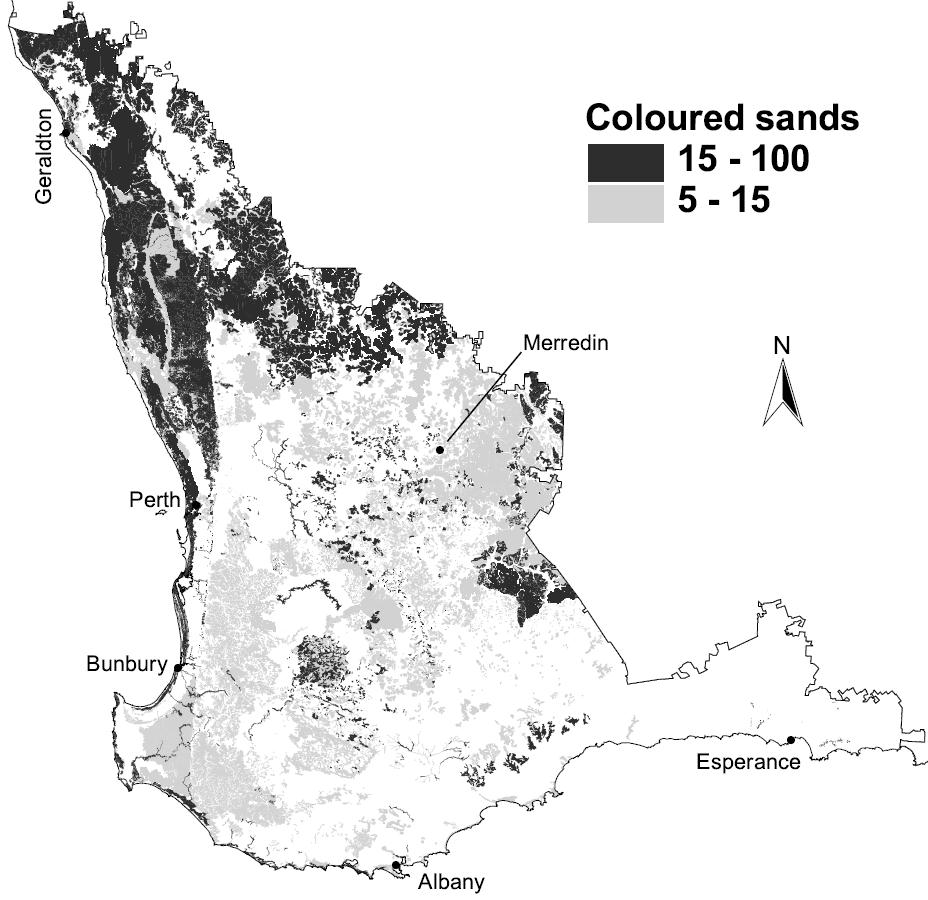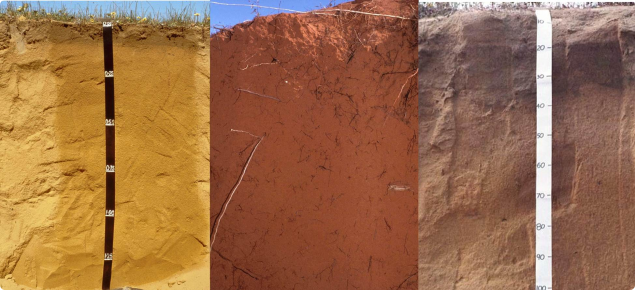Identifying properties
- Loose sandy surface, sometimes loamy sand due to small amounts of organic matter
- Red, yellow or brown colour. May be grey at surface
- Little or no soil structure - loose single grains fine or medium grained with very small amounts of clay
- Well drained, generally rapid profile permeability
- Neutral or acid pH
- Some gravels in profile, especially in yellow deep sands.

Map of distribution
Key soil issues
| Issue | Description |
|---|---|
| Water storage | The sandy textures result in generally low to moderately low soil water storage. Soil with fine sand fractions have higher water storage compared to sands with course sand fractions. Combined with good crop rooting conditions better sands can be very productive. |
| Fertility | These soils typically have low natural fertility. |
| Alkalinity | These soils are rarely alkaline. Yellow and red sands on the coastal dunes are associated with limestone, but these are not major cropping soils. (Calcareous sands are grouped with pale sands). |
| Acidity and aluminium toxicity | Some of these soils are highly acidic in the subsurface horizons. The highly acidic versions frequently have toxic levels of subsoil acidity requiring amelioration with lime. Most of these sands have a high risk of subsurface acidification or are presently acid at depth. |
| Salinity | Soil salinity is uncommon. |
| Hardpan and gravel | Hardpans are rare. Subsurface compaction pan (traffic pans) can develop under machinery necessitating occasional deep ripping. Small amounts of ironstone are common throughout the profiles but do not normally impact on production. |
| Shallow soil depth | These soils are usually deep with few physical rooting restrictions. |
| Boron toxicity | Nil. |
| Soil structure | These soils are usually loose with little soil structure. |
| Perched water tables | Perched watertables can occur at low positions in the landscape. |
| Water repellence | The sandy topsoils are prone to water repellence. |
| Hard setting topsoil | The sandy topsoils are not usually hard setting. |
| Erodibility | The sandy topsoils are prone to wind erosion, especially in exposed windy positions such as crests nearer the coast. Water repellent topsoils may also erode in heavy rain, especially during summer thunderstorms when the protective surface cover of vegetation is often at its lowest. |
| Workability | These soils are easy to work. |
West Australian (WA) Soil Groups included in this category
| WA Soil Group (Ref no.) | Brief description | Common names | Plant available water capacity (millimetres per minute (mm/m))** |
|---|---|---|---|
| Red deep sand (445) | Red sands more than 80 centimetres (cm) deep | Red sand, Pindan sand, Wandarrie sand | Moderately low to very low |
| Brown deep sand (441) | Brown sands more than 80cm deep | Brown sand, Alluvial sand, Alluvial brown sand | Moderately low to very low |
| Yellow deep sand (446) | Yellow sands more the 80cm deep | Yellow sand, Pear and pine sand, sandplain, Spearwood sand, Eradu sandplain, Sands on limestone, Karrakatta sand, Siliceous sand | Low, but ranging from extremely low to moderately low |
** Extremely low: <30mm/m
Very low: 30 - 50mm/m
Low: 50 - 70mm/m
Moderately low: 70 - 100mm/m
Moderate: 100 - 130mm/m
High: >130mm/m
Bold indicates the dominant or most common values.

